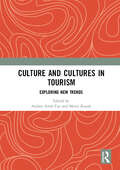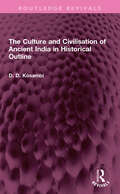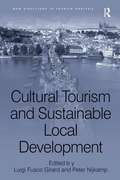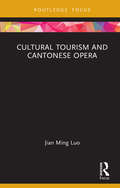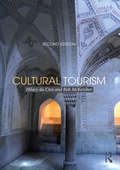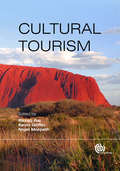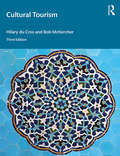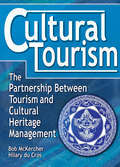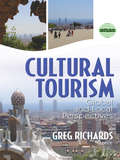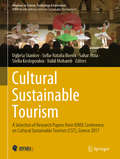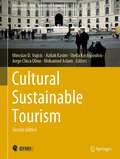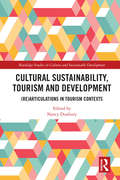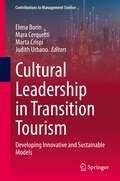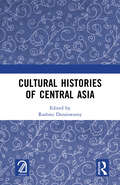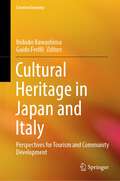- Table View
- List View
Culture and Cultures in Tourism: Exploring New Trends
by Andres Artal-Tur; Metin KozakAccording to the World Tourism Organization (UNWTO), international tourists engaging in cultural activities accounted for more than 500 million of international tourist numbers in 2017. City tourism relies on culture as a major product, providing benefits not only for interested visitors, but also for the local resident population. New trends in tourism include "experiential tourism", where the interactions between tourists and residents become a key part of the tourism experience and overall customer satisfaction. New technologies and IT applications allow tourists to design their own trip, given the presence of global companies like Trip Advisor, Booking.com and AirBnB. This comprehensive volume explores new trends in cultural tourism, demonstrating how and why culture has become a central factor in tourism. The authors analyse a wide range of relevant issues, including: how heritage-based and cultural tourism could contribute to the sustainability of destinations; the increase of religious travels to and within Arab countries; and how cultural tourism fosters understanding among people and cultures, and could even potentially help to consolidate peace at a regional level. The book also analyses interactions between hosts (the local residents) and guests (the cultural visitors), revisiting the pioneer hippy travelling experiences in Turkey of the 1960s and how they shaped youth culture. This book will be of great interest to students and researchers of cultural tourism. The chapters were originally published in the journal Anatolia.
Culture and Cultures in Tourism: Exploring New Trends
by Andrés Artal-Tur Metin KozakAccording to the World Tourism Organization (UNWTO), international tourists engaging in cultural activities accounted for more than 500 million of international tourist numbers in 2017. City tourism relies on culture as a major product, providing benefits not only for interested visitors, but also for the local resident population. New trends in tourism include "experiential tourism", where the interactions between tourists and residents become a key part of the tourism experience and overall customer satisfaction. New technologies and IT applications allow tourists to design their own trip, given the presence of global companies like Trip Advisor, Booking.com and AirBnB. This comprehensive volume explores new trends in cultural tourism, demonstrating how and why culture has become a central factor in tourism. The authors analyse a wide range of relevant issues, including: how heritage-based and cultural tourism could contribute to the sustainability of destinations; the increase of religious travels to and within Arab countries; and how cultural tourism fosters understanding among people and cultures, and could even potentially help to consolidate peace at a regional level. The book also analyses interactions between hosts (the local residents) and guests (the cultural visitors), revisiting the pioneer hippy travelling experiences in Turkey of the 1960s and how they shaped youth culture. This book will be of great interest to students and researchers of cultural tourism. The chapters were originally published in the journal Anatolia.
The Culture and Civilisation of Ancient India in HIstorical Outline (Routledge Revivals)
by D D KosambiFirst published in 1965, The Culture and Civilisation of Ancient India in Historical Outline is a strikingly original work, the first real cultural history of India. The main features of the Indian character are traced back into remote antiquity as the natural outgrowth of historical process. Did the change from food gathering and the pastoral life to agriculture make new religions necessary? Why did the Indian cities vanish with hardly a trace and leave no memory? Who were the Aryans – if any? Why should Buddhism, Jainism, and so many other sects of the same type come into being at one time and in the same region? How could Buddhism spread over so large a part of Asia while dying out completely in the land of its origin? What caused the rise and collapse of the Magadhan empire; was the Gupta empire fundamentally different from its great predecessor, or just one more ‘oriental despotism’? These are some of the many questions handled with great insight, yet in the simplest terms, in this stimulating work. This book will be of interest to students of history, sociology, archaeology, anthropology, cultural studies, South Asian studies and ethnic studies.
The Culture and Civilisation of Ancient India in HIstorical Outline (Routledge Revivals)
by D D KosambiFirst published in 1965, The Culture and Civilisation of Ancient India in Historical Outline is a strikingly original work, the first real cultural history of India. The main features of the Indian character are traced back into remote antiquity as the natural outgrowth of historical process. Did the change from food gathering and the pastoral life to agriculture make new religions necessary? Why did the Indian cities vanish with hardly a trace and leave no memory? Who were the Aryans – if any? Why should Buddhism, Jainism, and so many other sects of the same type come into being at one time and in the same region? How could Buddhism spread over so large a part of Asia while dying out completely in the land of its origin? What caused the rise and collapse of the Magadhan empire; was the Gupta empire fundamentally different from its great predecessor, or just one more ‘oriental despotism’? These are some of the many questions handled with great insight, yet in the simplest terms, in this stimulating work. This book will be of interest to students of history, sociology, archaeology, anthropology, cultural studies, South Asian studies and ethnic studies.
Cultural Tourism And Sustainable Local Development (PDF)
by Peter Nijkamp Luigi Fusco GirardWith the exponential rise in leisure mobility, tourism has increasingly become of great economic significance. Cultural heritage, such as museums, churches, historical landscapes, urban parks, and exhibitions attract many visitors and countries, regions and cities which house such historic-cultural amenities have seen increasingly large waves of tourists. While an avalanche of tourists has a positive impact on the local economy, such modern mass tourism also brings about negative externalities such as congestion, decline in quality of life, low access to cultural amenities and loss of local identity; to the extent that the sustainability conditions of a locality might be endangered. This tourism dilemma is particularly pronounced in cities with a rich cultural past, such as Venice, Naples and Amsterdam. Bringing together an interdisciplinary team of leading scholars from North America and Europe, this book examines the interface of local cultural resources and modern mass tourism from a sustainability perspective. It puts forward innovative methodologies and best case practice for future cultural conservation policies.
Cultural Tourism And Sustainable Local Development
by Peter Nijkamp Luigi Fusco GirardWith the exponential rise in leisure mobility, tourism has increasingly become of great economic significance. Cultural heritage, such as museums, churches, historical landscapes, urban parks, and exhibitions attract many visitors and countries, regions and cities which house such historic-cultural amenities have seen increasingly large waves of tourists. While an avalanche of tourists has a positive impact on the local economy, such modern mass tourism also brings about negative externalities such as congestion, decline in quality of life, low access to cultural amenities and loss of local identity; to the extent that the sustainability conditions of a locality might be endangered. This tourism dilemma is particularly pronounced in cities with a rich cultural past, such as Venice, Naples and Amsterdam. Bringing together an interdisciplinary team of leading scholars from North America and Europe, this book examines the interface of local cultural resources and modern mass tourism from a sustainability perspective. It puts forward innovative methodologies and best case practice for future cultural conservation policies.
Cultural Tourism and Cantonese Opera (Routledge Cultural Heritage and Tourism Series)
by Jian Ming LuoCultural tourism is an experiential tourism based on searching for and participating in new and deep cultural experiences. This book enhances the tourism literature by testing the tourist attitude toward related issues of Cantonese Opera as a cultural product of the Greater Bay Area. This book starts with a general introduction to the background of Cantonese Opera. Chapter 2 is a historical review of Cantonese Opera development in the GBA. Chapter 3 introduces the concept of the Cantonese Opera as a cultural product. Chapter 4 discusses the related Cantonese Opera on tourism development in the GBA. Chapter 5 describes the trends of modernisation and integration of Cantonese Opera in the GBA. Lastly, Chapter 6 is a case study in Macau. This book focuses on Cantonese Opera and cultural tourism. This means tourism practitioners and arts administrators should be the primary source of market and while people in the rest of the world who are interested in Cantonese Opera and cultural tourism should find this book useful. This book is a valuable resource not only for social science researchers, but also for those in related fields, for example, arts administrators and tourism officers, among many others. This book could serve as a text for an advanced level undergraduate course for students in many of the arts administration and tourism fields. Additionally, this book is a valuable resource for teaching graduate students not only in tourism, but also in related fields. Furthermore, government or practitioners can improve the management of city and tourism service using this book.
Cultural Tourism and Cantonese Opera (Routledge Cultural Heritage and Tourism Series)
by Jian Ming LuoCultural tourism is an experiential tourism based on searching for and participating in new and deep cultural experiences. This book enhances the tourism literature by testing the tourist attitude toward related issues of Cantonese Opera as a cultural product of the Greater Bay Area. This book starts with a general introduction to the background of Cantonese Opera. Chapter 2 is a historical review of Cantonese Opera development in the GBA. Chapter 3 introduces the concept of the Cantonese Opera as a cultural product. Chapter 4 discusses the related Cantonese Opera on tourism development in the GBA. Chapter 5 describes the trends of modernisation and integration of Cantonese Opera in the GBA. Lastly, Chapter 6 is a case study in Macau. This book focuses on Cantonese Opera and cultural tourism. This means tourism practitioners and arts administrators should be the primary source of market and while people in the rest of the world who are interested in Cantonese Opera and cultural tourism should find this book useful. This book is a valuable resource not only for social science researchers, but also for those in related fields, for example, arts administrators and tourism officers, among many others. This book could serve as a text for an advanced level undergraduate course for students in many of the arts administration and tourism fields. Additionally, this book is a valuable resource for teaching graduate students not only in tourism, but also in related fields. Furthermore, government or practitioners can improve the management of city and tourism service using this book.
Cultural Tourism: The Partnership Between Tourism And Cultural Heritage Management
by Hilary Du Cros Bob McKercherCultural Tourism remains the only book to bridge the gap between cultural tourism and cultural and heritage management. The first edition illustrated how heritage and tourism goals can be integrated in a management and marketing framework to produce sustainable cultural tourism. The current edition takes this further to base the discussion of cultural tourism in the theory and practice of cultural and heritage management (CM and CHM), under the understanding that for tourism to thrive, a balanced approach to the resource base it uses must be maintained. An ‘umbrella approach’ to cultural tourism represents a unique feature of the book, proposing solutions to achieve an optimal outcome for all sectors. Reflecting the many important developments in the field this new edition has been completely revised and updated in the following ways:• New sections on tangible and intangible cultural heritage and world heritage sites. • Expanded material on cultural tourism product development, the cultural tourism market and consumer behaviour, planning and delivery of exceptional experiences • New case studies throughout drawn from cultural attractions in developing countries such as Southeast Asia, China, South Africa and the Pacific as well as from the developed world, particularly the United States, Britain, Japan, Singapore, Australia and Canada. Written by experts in both tourism and cultural heritage management, this book will enable professionals and students to gain a better understanding of their own and each other’s roles in achieving sustainable cultural tourism. It provides a blueprint for producing top-quality, long-term cultural tourism products.
Cultural Tourism
by Hilary Du Cros Bob McKercherCultural Tourism remains the only book to bridge the gap between cultural tourism and cultural and heritage management. The first edition illustrated how heritage and tourism goals can be integrated in a management and marketing framework to produce sustainable cultural tourism. The current edition takes this further to base the discussion of cultural tourism in the theory and practice of cultural and heritage management (CM and CHM), under the understanding that for tourism to thrive, a balanced approach to the resource base it uses must be maintained. An ‘umbrella approach’ to cultural tourism represents a unique feature of the book, proposing solutions to achieve an optimal outcome for all sectors. Reflecting the many important developments in the field this new edition has been completely revised and updated in the following ways:• New sections on tangible and intangible cultural heritage and world heritage sites. • Expanded material on cultural tourism product development, the cultural tourism market and consumer behaviour, planning and delivery of exceptional experiences • New case studies throughout drawn from cultural attractions in developing countries such as Southeast Asia, China, South Africa and the Pacific as well as from the developed world, particularly the United States, Britain, Japan, Singapore, Australia and Canada. Written by experts in both tourism and cultural heritage management, this book will enable professionals and students to gain a better understanding of their own and each other’s roles in achieving sustainable cultural tourism. It provides a blueprint for producing top-quality, long-term cultural tourism products.
Cultural Tourism
by Jon Edwards Carlos Fernandes Wided Majdoub Claudia Kroesbacher Ian Rotherham Tahir Rashid Catherine Gorman Frances McGettigan Vincent Zamitt Manon Niesten Lia Bassa Kelli Ann Malone Ivana Pavlic Jane Legget Anna Thompson Dr Dolors Vidal-Casellas Alexandra Tirca Neus Crous-CostaWith contributions from international experts this book provides a broad discussion of cultural tourism as a concept and the way it is implemented in diverse regions around the world. Addressing the notion of cultural tourism and what it means to tourism as an industry, and also types of cultural tourism offered to tourists and experienced by them. Many international case studies will be included on specific instances of cultural tourism, and current topics such as cultural tourism's relationship to sustainability are discussed.
Cultural Tourism
by Bob McKercher Hilary du CrosCultural Tourism remains the only book to bridge the gap between cultural tourism and cultural and heritage management. The first edition illustrated how heritage and tourism goals can be integrated in a management and marketing framework to produce sustainable cultural tourism. The current edition takes this further to base the discussion of cultural tourism in the theory and practice of cultural and heritage management (CM and CHM), under the understanding that for tourism to thrive, a balanced approach to the resource base it uses must be maintained. An ‘umbrella approach’ to cultural tourism represents a unique feature of the book, proposing solutions to achieve an optimal outcome for all sectors. Reflecting the many important developments in the field this new edition has been completely revised and updated in the following ways: New content on increasingly relevant topics including sustainability, climate change, the threat of de-globalization, overtourism and social media. New sections on experience creation, accessibility and inclusivity, as well as expanded material on creative industries and new management challenges. New international case studies and tried-and-tested assignment exercises have been added to every chapter. Written by experts in both tourism and cultural heritage management, this book will enable professionals and students to gain a better understanding of their own and each other’s roles in achieving sustainable cultural tourism. It provides a blueprint for producing top-quality, long-term cultural tourism products.
Cultural Tourism: The Partnership Between Tourism and Cultural Heritage Management
by bob Mckercher hilary du crosExamine cultural tourism issues from both sides of the industry!Unique in concept and content, Cultural Tourism: The Partnership Between Tourism and Cultural Heritage Management examines the relationship between the sectors that represent opposite sides of the cultural tourism coin. While tourism professionals assess cultural assets for their profit potential, cultural heritage professionals judge the same assets for their intrinsic value. Sustainable cultural tourism can only occur when the two sides form a true partnership based on understanding and appreciation of each other's merits. The authors--one, a tourism specialist, the other, a cultural heritage management expert--present a model for a working partnership with mutual benefits, integrating management theory and practice from both disciplines.Cultural Tourism is the first book to combine the different perspectives of tourism management and cultural heritage management. It examines the role of tangible (physical evidence of culture) and intangible (continuing cultural practices, knowledge, and living experiences) heritage, describes the differences between cultural tourism products and cultural heritage assets, and develops a number of conceptual models, including a classification system for cultural tourists, indicators of tourism potential at cultural and heritage assets, and assessment criteria for cultural and heritage assets with tourism potential. Cultural Tourism examines the five main constituent elements involved in cultural tourism: cultural and heritage assets in tourism sites such as the Royal Palace in Bangkok, the Cook Islands, and Alcatraz Prison in San Francisco. tourism--what it is, how it works, and what makes it a success five different types of cultural tourists consumption of products, value adding, and commodification integrating the first four elements to satisfy the tourist, meet the needs of the tourism industry, and conserve the intrinsic value of the assetThough tourism and cultural heritage management professionals have mutual interests in the management, conservation, and presentation of cultural and heritage assets, the two sectors operate on parallel planes, maintaining an uneasy partnership with surprisingly little dialogue. Cultural Tourism provides professionals and students in each field with a better understanding of their own roles in the partnership, bridging the gap via sound planning, management, and marketing to produce top-quality, long-lasting cultural tourism products.Now translated into simplified Chinese.
Cultural Tourism: The Partnership Between Tourism and Cultural Heritage Management
by bob Mckercher hilary du crosExamine cultural tourism issues from both sides of the industry!Unique in concept and content, Cultural Tourism: The Partnership Between Tourism and Cultural Heritage Management examines the relationship between the sectors that represent opposite sides of the cultural tourism coin. While tourism professionals assess cultural assets for their profit potential, cultural heritage professionals judge the same assets for their intrinsic value. Sustainable cultural tourism can only occur when the two sides form a true partnership based on understanding and appreciation of each other's merits. The authors--one, a tourism specialist, the other, a cultural heritage management expert--present a model for a working partnership with mutual benefits, integrating management theory and practice from both disciplines.Cultural Tourism is the first book to combine the different perspectives of tourism management and cultural heritage management. It examines the role of tangible (physical evidence of culture) and intangible (continuing cultural practices, knowledge, and living experiences) heritage, describes the differences between cultural tourism products and cultural heritage assets, and develops a number of conceptual models, including a classification system for cultural tourists, indicators of tourism potential at cultural and heritage assets, and assessment criteria for cultural and heritage assets with tourism potential. Cultural Tourism examines the five main constituent elements involved in cultural tourism: cultural and heritage assets in tourism sites such as the Royal Palace in Bangkok, the Cook Islands, and Alcatraz Prison in San Francisco. tourism--what it is, how it works, and what makes it a success five different types of cultural tourists consumption of products, value adding, and commodification integrating the first four elements to satisfy the tourist, meet the needs of the tourism industry, and conserve the intrinsic value of the assetThough tourism and cultural heritage management professionals have mutual interests in the management, conservation, and presentation of cultural and heritage assets, the two sectors operate on parallel planes, maintaining an uneasy partnership with surprisingly little dialogue. Cultural Tourism provides professionals and students in each field with a better understanding of their own roles in the partnership, bridging the gap via sound planning, management, and marketing to produce top-quality, long-lasting cultural tourism products.Now translated into simplified Chinese.
Cultural Tourism
by Bob McKercher Hilary du CrosCultural Tourism remains the only book to bridge the gap between cultural tourism and cultural and heritage management. The first edition illustrated how heritage and tourism goals can be integrated in a management and marketing framework to produce sustainable cultural tourism. The current edition takes this further to base the discussion of cultural tourism in the theory and practice of cultural and heritage management (CM and CHM), under the understanding that for tourism to thrive, a balanced approach to the resource base it uses must be maintained. An ‘umbrella approach’ to cultural tourism represents a unique feature of the book, proposing solutions to achieve an optimal outcome for all sectors. Reflecting the many important developments in the field this new edition has been completely revised and updated in the following ways: New content on increasingly relevant topics including sustainability, climate change, the threat of de-globalization, overtourism and social media. New sections on experience creation, accessibility and inclusivity, as well as expanded material on creative industries and new management challenges. New international case studies and tried-and-tested assignment exercises have been added to every chapter. Written by experts in both tourism and cultural heritage management, this book will enable professionals and students to gain a better understanding of their own and each other’s roles in achieving sustainable cultural tourism. It provides a blueprint for producing top-quality, long-term cultural tourism products.
Cultural Tourism: Global and Local Perspectives (Tourism And Cultural Change Ser. #3)
by Greg RichardsA unique chance to explore different aspects of place, heritage, and tourismFor many nations around the world, cultural tourism is not only a major industry but also a support for national identity and a means for preserving heritage. Cultural Tourism: Global and Local Perspectives brings together in one volume interdisciplinary explora
Cultural Tourism: Global and Local Perspectives
by Greg RichardsA unique chance to explore different aspects of place, heritage, and tourismFor many nations around the world, cultural tourism is not only a major industry but also a support for national identity and a means for preserving heritage. Cultural Tourism: Global and Local Perspectives brings together in one volume interdisciplinary explora
Cultural Sustainable Tourism: A Selection of Research Papers from IEREK Conference on Cultural Sustainable Tourism (CST), Greece 2017 (Advances in Science, Technology & Innovation)
by Uglješa Stankov Sofia-Natalia Boemi Sahar Attia Stella Kostopoulou Nabil MoharebThis book includes research papers submitted to and presented during the first international conference on Cultural Sustainable Tourism (CST) that was held in Thessaloniki, Greece in November of 2017. Discussing complex relations between Culture, tourism, and the role of planners and architects in their maintenance, this conference was jointly organized by IEREK –International Experts for Research Enrichment and Knowledge Exchange- and Aristotle University of Thessaloniki. The conference was an attempt to shed a light on the significance of Culture and Heritage as two important factors attracting tourists and promoting economic growth and convey civilizations through tourism. Themes covered in this book give an overview on current research and topics of discussion that focus on Cultural sustainable tourism through several sections. The first section, titled “Art, Architecture and Culture”, discusses urban regeneration as a road to the preservation of cultural and tourist destinations and the importance of understanding and benefitting from our heritage to allow for modern day improvements. “Heritage Tourism”, the section 2 of the book, is more focused on offering nontraditional solutions and management plans to sustain cultural tourism and improve quality of life around historically significant areas. The third section on the “City and Rural Tourism” follows by providing sustainable strategies to attract tourists and promoting the use of existing resources. The last and final section with the title of “Sustainable Tourism, Development and Environmental Management” maneuvers around the different yet common environmental issues existing today and proposes new and innovative solutions for their elimination. Presenting a wide range of topics in chapters, this book provides the scientific community with a collection of unique and enlightening literature.
Cultural Sustainable Tourism (Advances in Science, Technology & Innovation)
by Miroslav D. Vujicic Azilah Kasim Stella Kostopoulou Jorge Chica Olmo Mohamed AslamThis book is an assemblage of diverse yet homogenous research papers that bring together the issues and challenges of cultural heritage conservation and tourism sustainability. The richness of this book stems from its inclusion of diverse case studies from around the globe while scrutinizing the cases of both deterioration and sustainability of cultural heritage belonging to different eras.This book sheds light on the connections between culture as an essential dimension of local sustainability and cultural dimensions of sustainable tourism, further contributing to the complex discussion between culture and tourism. This book gives an overview of current research and subjects of discussion that focuses on cultural sustainable tourism through several sections, such as planning and management of sustainable tourism, sustainable cultural tourism development in a digital era, social and economic impacts of cultural tourism, and sustainable tourism development in urban areas
Cultural Sustainability, Tourism and Development: (Re)articulations in Tourism Contexts (Routledge Studies in Culture and Sustainable Development)
by Nancy DuxburyCultural Sustainability, Tourism and Development considers how tourism provides a lens to examine issues of cultural sustainability and change. It discusses how cultural and natural assets, artistic interventions, place identity, policy strategies, and community well-being are intertwined in (re)articulations of place and local dynamics that occur in tourist locations. With a primary focus on culture in sustainable development, the book clarifies connections between culture as a core dimension of local sustainability and cultural dimensions of sustainable tourism. It highlights the roles and place of cultural expression, artistic activity, and heritage resources in local or regional sustainable development contexts. Chapters critically examine the dimensions of tourism-invoked dynamics of change and the cultural impacts of tourism-related activities. The book concludes with proposals for new culture-informed and creativity-based approaches, mediations, and relations to encourage a better balance between visitors and residents’ quality of life and the broader sustainability of the area. Interdisciplinary and international in scope, contributions reflect on communities and rural areas located in Brazil, Canada, Croatia, India, Italy, Japan, the Netherlands, Poland, Portugal, and the United States. This book will be of great interest to students and scholars of cultural development and policy, heritage studies, cultural tourism and sustainable tourism, cultural geography, and regional development.
Cultural Sustainability, Tourism and Development: (Re)articulations in Tourism Contexts (Routledge Studies in Culture and Sustainable Development)
by Nancy DuxburyCultural Sustainability, Tourism and Development considers how tourism provides a lens to examine issues of cultural sustainability and change. It discusses how cultural and natural assets, artistic interventions, place identity, policy strategies, and community well-being are intertwined in (re)articulations of place and local dynamics that occur in tourist locations. With a primary focus on culture in sustainable development, the book clarifies connections between culture as a core dimension of local sustainability and cultural dimensions of sustainable tourism. It highlights the roles and place of cultural expression, artistic activity, and heritage resources in local or regional sustainable development contexts. Chapters critically examine the dimensions of tourism-invoked dynamics of change and the cultural impacts of tourism-related activities. The book concludes with proposals for new culture-informed and creativity-based approaches, mediations, and relations to encourage a better balance between visitors and residents’ quality of life and the broader sustainability of the area. Interdisciplinary and international in scope, contributions reflect on communities and rural areas located in Brazil, Canada, Croatia, India, Italy, Japan, the Netherlands, Poland, Portugal, and the United States. This book will be of great interest to students and scholars of cultural development and policy, heritage studies, cultural tourism and sustainable tourism, cultural geography, and regional development.
Cultural Leadership in Transition Tourism: Developing Innovative and Sustainable Models (Contributions to Management Science)
by Elena Borin Mara Cerquetti Marta Crispí Judith UrbanoCultural tourism has proved to be a significant source of economic development for cultural destinations, but it has also emerged as a sometimes potentially controversial and unsustainable phenomenon. The recent pandemic has also pointed out that we need different models of development of tourism, that include a more balanced approach to cultural components in cities and rural areas. Calls have been made on the need to design more sustainable models of tourism development for cultural destinations, conceiving tourism as a means to increasing the quality of life and generating economic opportunities in cities and regions by involving their communities and stakeholders. This book presents an in-depth analysis of the transition towards more sustainable models of cultural tourism development. Starting from the ongoing debate on cultural ecosystems, the book explores the potential key role of cultural and creative organizations as leaders of change. Including theoretical contributions, quantitative and qualitative analyses and international case studies, the book explores the role of cultural actors as leaders and their potential as drivers of culture-led innovation for tourism in cities and regions.
Cultural Histories of Central Asia
by Rashmi DoraiswamyCentral Asia, the 'heart' of the Eurasian landmass, has through the centuries been the hub of diverse and varied cultures. These cultures have encompassed pre-Islamic religions and Islam, sedentary and nomadic lifestyles and lived through rapid transitions from feudal, capitalist and socialist economies, from Tsarist to Soviet and post-Soviet formations. The essays in this volume examine the cultural exchanges and encounters that have occurred in the region through a vast timeline that extends from the premedieval to the medieval and modern periods. The writers are academics, as well as art practitioners and independent researchers who belong to a wide spectrum of disciplines: Central Asian and Russian Studies, Architecture, Ethno-Musicology, History, Painting, Film Studies, Art History, Textiles, Literature and International Relations. The volume presents a colourful mosaic of views on the many cultural histories of Central Asia.
Cultural Histories of Central Asia
by Rashmi DoraiswamyCentral Asia, the 'heart' of the Eurasian landmass, has through the centuries been the hub of diverse and varied cultures. These cultures have encompassed pre-Islamic religions and Islam, sedentary and nomadic lifestyles and lived through rapid transitions from feudal, capitalist and socialist economies, from Tsarist to Soviet and post-Soviet formations. The essays in this volume examine the cultural exchanges and encounters that have occurred in the region through a vast timeline that extends from the premedieval to the medieval and modern periods. The writers are academics, as well as art practitioners and independent researchers who belong to a wide spectrum of disciplines: Central Asian and Russian Studies, Architecture, Ethno-Musicology, History, Painting, Film Studies, Art History, Textiles, Literature and International Relations. The volume presents a colourful mosaic of views on the many cultural histories of Central Asia.
Cultural Heritage in Japan and Italy: Perspectives for Tourism and Community Development (Creative Economy)
by Nobuko Kawashima Guido FerilliThis edited book represents one of the first scholarly research through an international collaboration project between Japan and Italy to address economic and social values of cultural heritage beyond its inherent—historic, archaeological, or aesthetic—values. Cultural policies in the world have over the decades expanded to include non-cultural purposes such as economic development and social inclusion. Japanese cultural policy for heritage is catching up on this trend: we have seen major shifts of emphasis from preservation for its sake to the utilisation of cultural heritage for the purposes of tourism, place branding, local vitalization and community-building, whilst Italy has long thrived on the economy of heritage tourism and more cases are being seen for urban and regional development with the use of cultural assets. The recent outbreak of Covid-19 and the problem of over-tourism that preceded it have challenged tourism policy and practice in the two countries.This book identifies emerging trends, issues, and problems in such policy shifts. The book breaks a new ground in the bourgeoning studies of tourism, heritage, and cultural policy by adopting an international, inter-disciplinary approach. The chapters on Japan in particular make an original contribution to these fields in the English literature in which discussion of Japan despite its economic and cultural presence on the globe has hitherto been less available.
